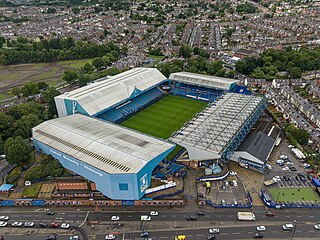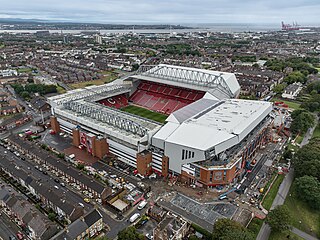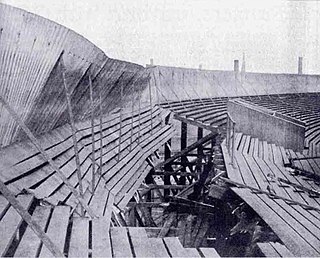
The Hillsborough disaster was a fatal human crush during a football match at Hillsborough Stadium in Sheffield, South Yorkshire, England, on 15 April 1989. It occurred during an FA Cup semi-final between Liverpool and Nottingham Forest in the two standing-only central pens in the Leppings Lane stand allocated to Liverpool supporters. Shortly before kick-off, in an attempt to ease overcrowding outside the entrance turnstiles, the police match commander, David Duckenfield, ordered exit gate C to be opened, leading to an influx of supporters entering the pens. This resulted in overcrowding of those pens and the crush. With 97 deaths and 766 injuries, it has the highest death toll in British sporting history. Ninety-four people died on the day; another person died in hospital days later, and another victim died in 1993. In July 2021, a coroner ruled that Andrew Devine, who died 32 years later, after suffering severe and irreversible brain damage on the day, was the 97th victim. The match was abandoned and restaged at Old Trafford in Manchester on 7 May 1989; Liverpool won and went on to win that season's FA Cup.

Hillsborough Stadium is a football stadium in Sheffield, England. It has been the home of Sheffield Wednesday since opening in 1899.

Anfield is a football stadium in Anfield, Liverpool, Merseyside, England, which has a seating capacity of 61,015, making it the 5th largest football stadium in England. It has been the home of Liverpool since their formation in 1892. It was originally the home of Everton from 1884 to 1891, before they moved to Goodison Park after a dispute with the club president.

Ibrox Stadium is a football stadium on the south side of the River Clyde in the Ibrox area of Glasgow, Scotland. The home of Rangers Football Club, Ibrox is the third largest football stadium in Scotland, with an all-seated capacity of 50,817.
The Hillsborough Stadium Disaster Inquiry report is the report of an inquiry which was overseen by Lord Justice Taylor, into the causes of the Hillsborough disaster in Sheffield, South Yorkshire, England, on 15 April 1989, as a result of which, at the time of the report, 95 Liverpool F.C. fans had died. An interim report was published in August 1989, and the final report was published in January 1990.

Valley Parade, known as the University of Bradford Stadium for sponsorship reasons, is an all-seater football stadium in Bradford, West Yorkshire, England. Built in 1886, it was the home of Manningham Rugby Football Club until 1903, when they changed code from rugby football to association football and became Bradford City. It has been Bradford City's home since, although it is now owned by former chairman Gordon Gibb's pension fund. It has also been home to Bradford for one season, and Bradford Bulls rugby league side for two seasons, as well as host to a number of England youth team fixtures.

Páirc Uí Chaoimh is a Gaelic games stadium in Cork, Ireland. It is the home of Cork GAA. The venue, often referred to simply as The Park, is located in Ballintemple and is built near to the site of the original Cork Athletic Grounds. The stadium opened in 1976 and underwent a significant two-year redevelopment before reopening in 2017.

Spion Kop is a colloquial name or term for a number of single-tier terraces and stands at sports stadiums, particularly in the United Kingdom, the most famous example of which is the Kop Stand at Liverpool F.C.'s home ground, Anfield.

Fratton Park is a football ground in Portsmouth, England and is the home of Portsmouth F.C.. Fratton Park's location on Portsea Island is unique in English professional football, as it is the only professional English football ground not found on the mainland of Great Britain. Fratton Park has been the only home football ground in Portsmouth FC's entire history.

Rugby Park, also known as The BBSP Stadium Rugby Park for sponsorship reasons, is a football stadium situated in the Scottish town of Kilmarnock. It was first used in 1899 and is the home of Kilmarnock F.C. Rugby Park has also been used for concerts, with Elton John playing to 15,000. In 2002, the club constructed the Park Hotel, a 4-star hotel complex next to the ground.

Adams Park is an association football stadium in High Wycombe, Buckinghamshire, England. Built in 1990, it is the home ground of the local Wycombe Wanderers in League One. It was also leased from 2002 to 2014 to the rugby union club London Wasps from Aviva Premiership, and from 2016 to 2020 to the Reading F.C. Women football club. From the 2003/04 season to the 2005/06 season, the stadium was officially called Causeway Stadium, named after its sponsor Causeway Technologies.

St Andrew's is an association football stadium in the Bordesley district of Birmingham, England. It has been the home ground of Birmingham City Football Club for more than a century. From 2018 to 2021, it was known for sponsorship reasons as St Andrew's Trillion Trophy Stadium.
Páirc Uí Rinn, also known as Páirc Chríostóir Uí Rinn, is a Gaelic Athletic Association stadium located between Ballinlough and Ballintemple in Cork. It was previously known as Flower Lodge and was used as an association football stadium. During the 1960s, 1970s and 1980s, Flower Lodge served as the home ground of three League of Ireland clubs – Cork Hibernians, Albert Rovers and Cork City. It also hosted friendly matches featuring Manchester United, Liverpool and the Republic of Ireland national football team. In 1989 it was purchased by Cork GAA and subsequently renamed after Christy Ring, a former Cork and Glen Rovers hurler. During the 1990s, 2000s and 2010s, Páirc Uí Rinn has served as Cork GAA's second home after Páirc Uí Chaoimh. It regularly hosts National Hurling League, National Football League, National Camogie League and All-Ireland Senior Camogie Championship fixtures.

An all-seater stadium is a sports stadium in which every spectator has a seat. This is commonplace in professional association football stadiums in nations such as the United Kingdom, Spain, and the Netherlands. Most association football and American football stadiums in the United States and Canadian Football League stadiums in Canada are all-seaters, as are most baseball and track and field stadiums in those countries. A stadium that is not an all-seater has areas for attendees holding standing-room only tickets to stand and view the proceedings. Such standing areas are known as terraces in Britain. Stands with only terraces used to dominate the football attendance in the UK. For instance, the South Bank Stand behind the southern goal at Molineux Stadium, home of Wolverhampton Wanderers, had a maximum of 32,000 standing attenders, while the rest of the stadium hosted a little bit less than that; the total maximum attendance was around 59,000.

The Racecourse Ground, known for sponsorship reasons as the STōK Cae Ras, is a football stadium in Wrexham, Wales. It is the home of Wrexham A.F.C.

Glanford Park is a football stadium in Scunthorpe, Lincolnshire, England, and is the current home of National League North team Scunthorpe United.

Prenton Park is a large outdoor seated association football stadium in Birkenhead, England. It is the home ground of Tranmere Rovers, as well as Liverpool's women and reserves teams. The ground has had several rebuilds, with the most recent occurring in 1995 in response to the requirement of the Taylor Report to become all-seater. Today's stadium holds 16,587 in four stands: the Kop, the Johnny King Stand, the Main Stand and the Cowshed.

Saltergate, officially the Recreation Ground, was the historic home of Chesterfield Football Club, and was in use from 1871 until the club's relocation in July 2010, a 139-year history that made it one of the oldest football grounds in England at the time of its closure. From the 1920s onward the name 'Saltergate' became predominant in popular references to the ground.

The 1902 Ibrox disaster was the collapse of a stand at Ibrox Park in Govan, Scotland. The incident led to the deaths of 25 supporters and injuries to 500 more during an international association football match between Scotland and England on 5 April 1902 as part of the 1901–02 British Home Championship.

Safe standing is a measure of design in stadia to ensure that spectators are able to stand safely during events. It is important in the context of association football in the United Kingdom, where a series of fatal incidents led to legislation requiring major clubs to develop all-seater stadiums during the 1990s. Since then, fan groups have campaigned against the ban on standing accommodation, arguing that new design options would allow designated standing areas to be built in compliance with all safety laws and guidelines. As these options are outlawed in England and Wales, safe standing in practice originated in continental Europe, primarily Germany. This occurred because although UEFA and FIFA required all-seater stadiums for international competition, it was not mandatory for domestic matches.






















